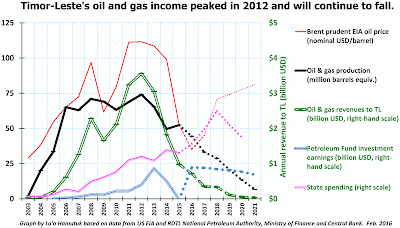Recent data have not been encouraging for the financial future of this petroleum-export-dependent country. Not only are oil prices still around $40/barrel, but the declining global stock market and the rising U.S. dollar (which caused our investments in other currencies to lose value) swallowed any potential income from Timor-Leste's Petroleum Fund -- the return on the Fund's investments in 2015 was negative $21 million. When combined with low revenues from oil and gas sales and large withdrawals to finance the state budget, the balance in the Petroleum Fund has begun to fall -- at the end of January it was $16.04 billion, the lowest since April 2014 and a billion dollars less than eight months ago.
Oil and finance professionals are invariably optimistic, and we hope that they are right that oil prices will rise again, the stock market will improve, and the U.S. dollar will stabilize against other currencies. If this happens, the Fund's balance will decline more slowly. However, it will only begin to increase if politicians are brave and far-seeing enough to sharply curtail public spending on wasteful mega-projects with dubious benefits -- a change of direction not visible in current planning.
Nevertheless, one factor in this equation is immutable; it will not change due to global finances or prudent budgeting. Our oil and gas reserves are non-renewable -- once they are sold they no longer exist. The Vice-Minister of Finance recently advised Ministers and other officials not to worry about oil prices because 90% of Timor-Leste's oil and gas has already been extracted and exported.
In fact, even this may be too hopeful. According to the latest reserves statement from Santos, a partner in the Bayu-Undan project, 93.3% of Bayu-Undan's 'Proved' deposits have already been extracted. Timor-Leste's other recently producing field, Kitan, is already shut down. Although Greater Sunrise may rise some day, the unpredictability of boundary disputes, floating/pipeline obstinacy and dubious profitability could take decades to resolve.
By then, our Petroleum Fund may no longer exist. If we continue to accelerate state spending, hiding the full costs by borrowing, where will the money to repay the debts come from? How will we maintain our nice new roads and airports? More importantly, will teachers, doctors, police and civil servants continue to serve the public when there is no money to pay them?
La'o Hamutuk has warned about Timor-Leste's fundamental fiscal fragility for several years, and we are gratified and saddened to see evidence from many sources confirming our dire predictions.
But decision-makers' heads remain in the sand. What will it take to make them look around, to see beyond next week or the next election? When will they realize that more than a million people, not only their cronies or interest groups, depend on them to advance equitable and sustainable development?
--------------------------------------------
P.S. The day after this blog was published, local newspapers reported the National Petroleum Authority (ANP) saying that ConocoPhillips will drill 5-7 "new wells" during the next two years to "maintain production until 2020." They failed to explain that these new wells are needed to extract the last bits of oil and gas from the Bayu-Undan field, and will not tap into any new fields. ANP's assertion that the wells have a 90% probability of success may be true because this field is already well understood, but it has nothing to do with looking for new petroleum reserves which could enlarge Timor-Leste's future revenues.
Furthermore, drilling these new wells will cost many millions of dollars. This cost is 'recoverable' from Bayu-Undan production -- so most if it will be subtracted from revenues which would have come to Timor-Leste.
We do not know if articles like this result from ANP obfuscation or journalistic incompetence, but it's no wonder that the newspaper-reading public is confused. Hopefully their leaders know better.
10 March 2016
Subscribe to:
Post Comments (Atom)








No comments:
Post a Comment